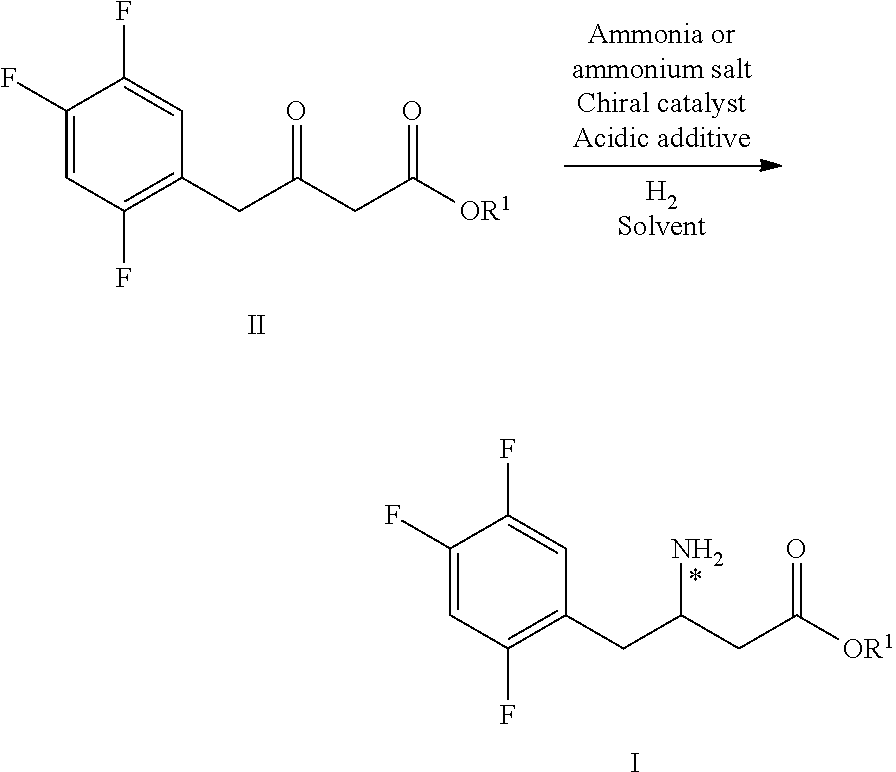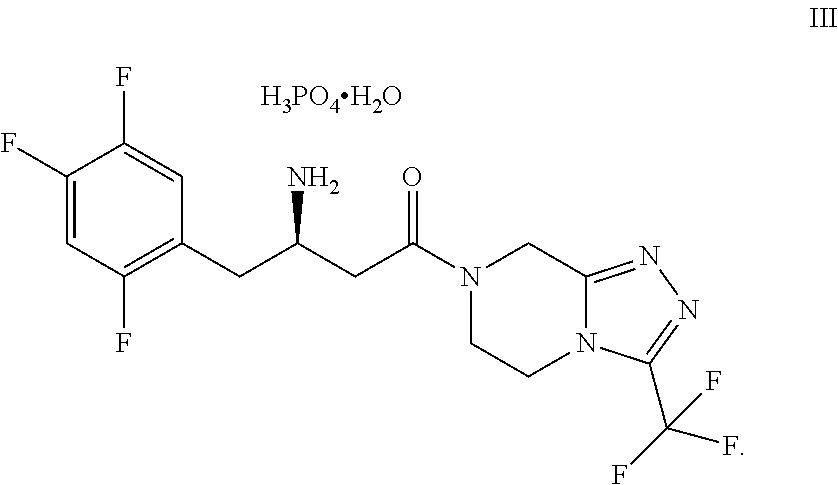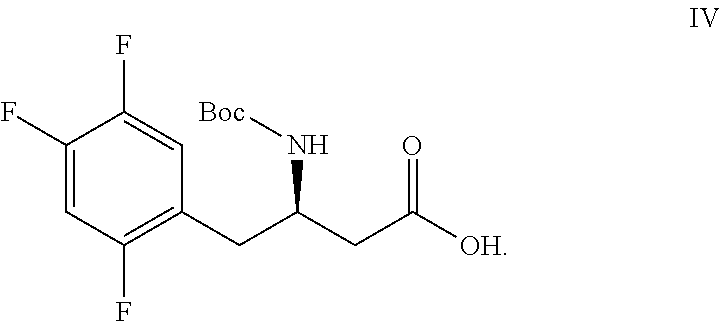Method for preparing sitagliptin intermediate via asymmetrical reduction method
a technology of asymmetric reduction and sitagliptin, which is applied in the preparation of carbamic acid derivatives, organic chemistry, physical/chemical process catalysts, etc., can solve the problems of high toxicity of bore gas, poor economic efficiency, and potential safety risks, and achieves short steps, high yield, and high atom utilization
- Summary
- Abstract
- Description
- Claims
- Application Information
AI Technical Summary
Benefits of technology
Problems solved by technology
Method used
Image
Examples
example 1
on of Compound C
[0033]
[0034]Under the protection of nitrogen, compound A (100 g, 0.524 mol), compound B (84 g, 0.583 mol), 4-dimethylaminopyridine (DMAP, 5.2 g, 0.042 mol) and acetonitrile (250 mL) were added sequentially into a 1000 mL three-necked flask, and were cooled to 0˜5° C. While the temperature was kept at 0˜30° C., triethylamine (150 mL, 1.079 mol) was added dropwise into the system. Then the system was cooled to 0˜5° C. While the system was kept not higher than 30° C., pivaloyl chloride (76 mL, 1.17 mol) was added dropwise into the system. After the addition was completed, the system was heated to 40˜45° C. The reaction was completed after 3˜5 hours. Then, the system was cooled to 25˜30° C. and filtrated. The filter cake was washed 2 times with 200 mL of methyl t-butyl ether. The solvent was evaporated (+.
example 2
on of Compound VI
[0035]
[0036]Under the protection of nitrogen, acetonitrile (284 mL), compound C (56.7 g, 0.179 mol), and benzyl alcohol (19.4 g, 0.179 mol) were added sequentially into a 250 mL three-necked flask, and then stirred. The system was heated to reflux for about 24 hours (inner temperature of 80˜84° C. is a normal boiling point). The system was then cooled to not higher than 30° C., concentrated, and supplemented with methanol 3 times the volume of the system. The crystallization was conducted at 0˜5° C. for 12 hours, followed by suction filtration, obtaining 47.2 g of product, with a yield of 81.6%. 1H NMR (400 MHz, CDCl3) δ: 7.37-7.35 (m, 5H), 6.99-6.89 (m, 2H), 5.19 (s, 2H), 3.81 (s, 2H), 3.57 (s, 2H); ESI: m / z: 323 [M+H]+.
example 3
on of Compound V
[0037]
[0038]Compound VI (100 g, 0.310 mol), salicylic acid (214 g, 0.898 mol), ammonium acetate (119 g, 1.544 mol), chiral catalyst Ru(OAc)2((R)-dm-Segphos) (2.93 g, 0.003 mol) and methanol (400 mL) were added into a 1000 mL hydrogenation reactor. The system was subjected to nitrogen replacement for 5 times, and to hydrogen replacement for 3 times, and then supplemented with hydrogen to the pressure of 2.5 MPa. The temperature was increased to 40˜50° C., and the pressure was increased to 2.7 MPa. Subsequently, hydrogen was added to the pressure of 3.6 MPa. The temperature was increased to 70˜80° C., and the pressure was 3.6 MPa. The reaction was conducted at a constant temperature. The reaction was monitored with TLC, and completed after about 20 hours. Then the heating was stopped, and the system was cooled to the room temperature. Hydrogen was discharged, and the system was subjected to nitrogen replacement for 3 times, followed by suction filtration of the reactio...
PUM
| Property | Measurement | Unit |
|---|---|---|
| Temperature | aaaaa | aaaaa |
| Pressure | aaaaa | aaaaa |
Abstract
Description
Claims
Application Information
 Login to View More
Login to View More - R&D
- Intellectual Property
- Life Sciences
- Materials
- Tech Scout
- Unparalleled Data Quality
- Higher Quality Content
- 60% Fewer Hallucinations
Browse by: Latest US Patents, China's latest patents, Technical Efficacy Thesaurus, Application Domain, Technology Topic, Popular Technical Reports.
© 2025 PatSnap. All rights reserved.Legal|Privacy policy|Modern Slavery Act Transparency Statement|Sitemap|About US| Contact US: help@patsnap.com



